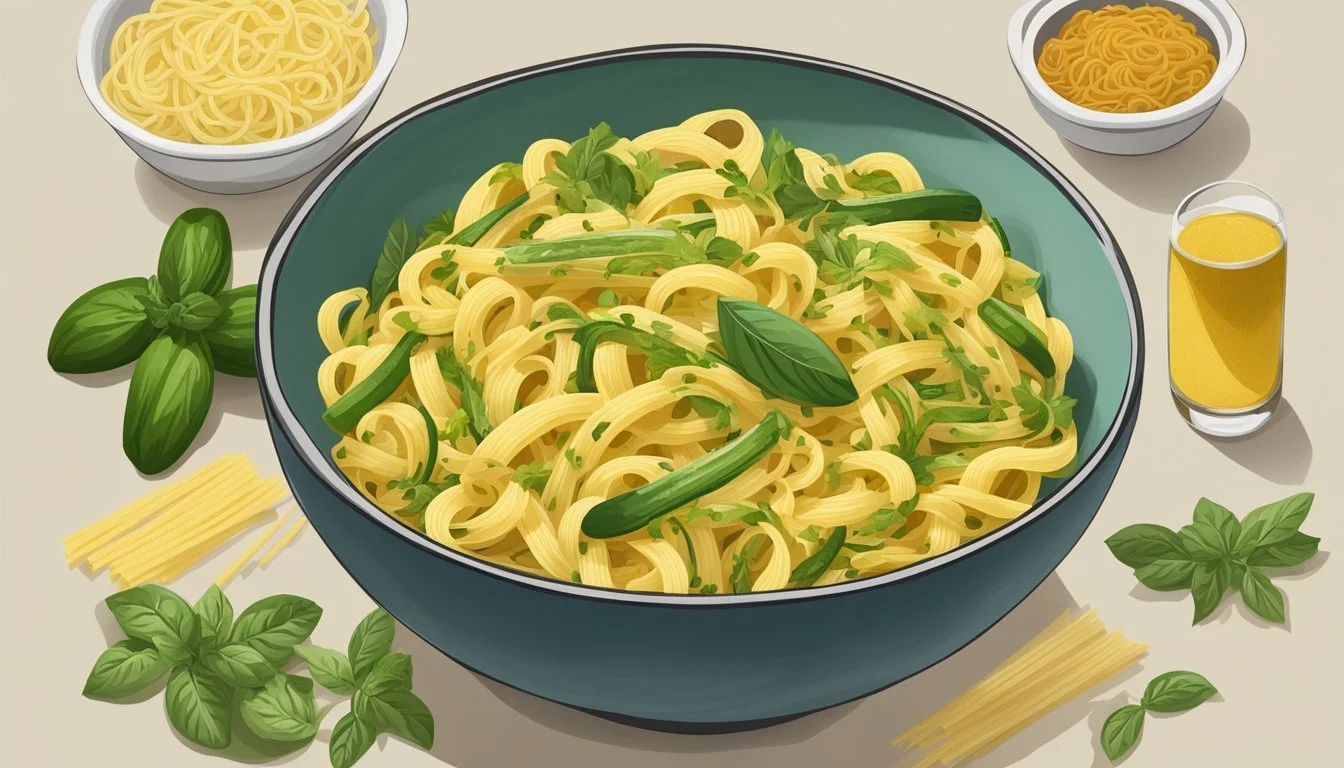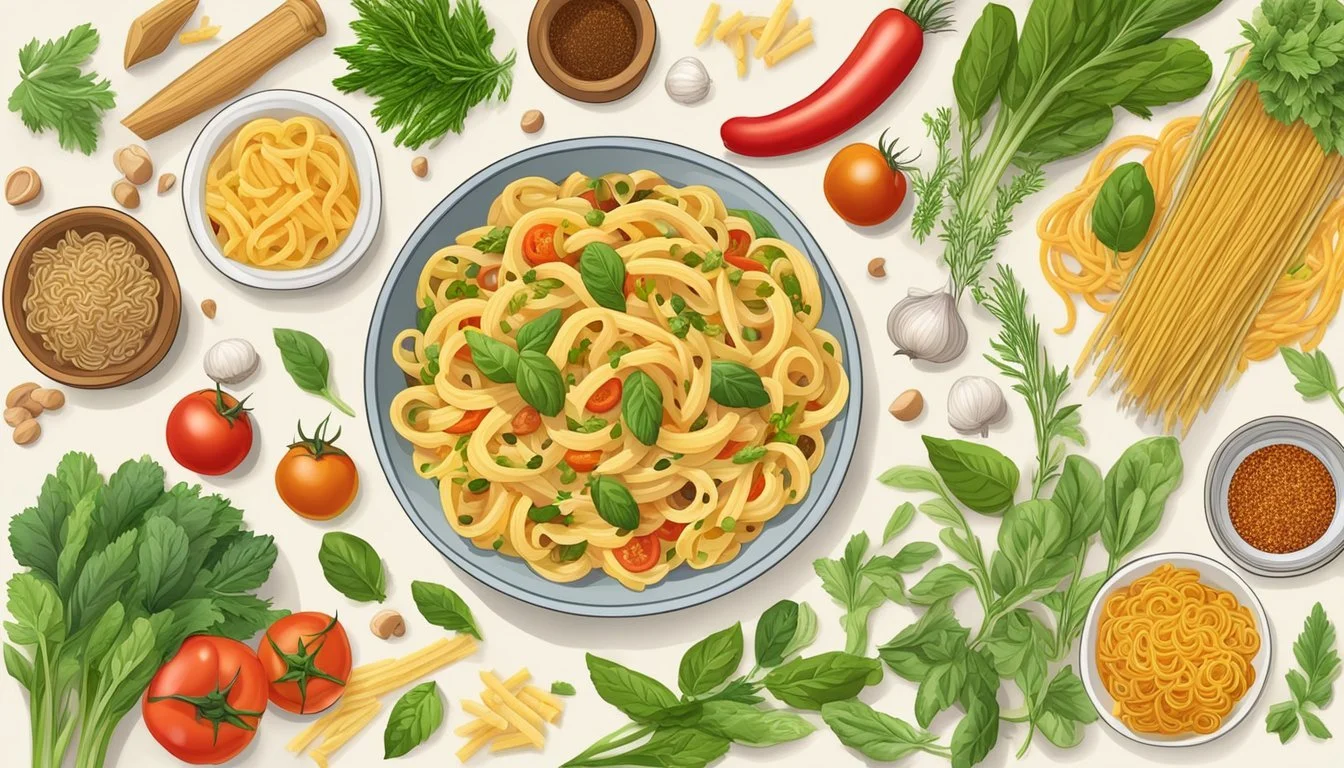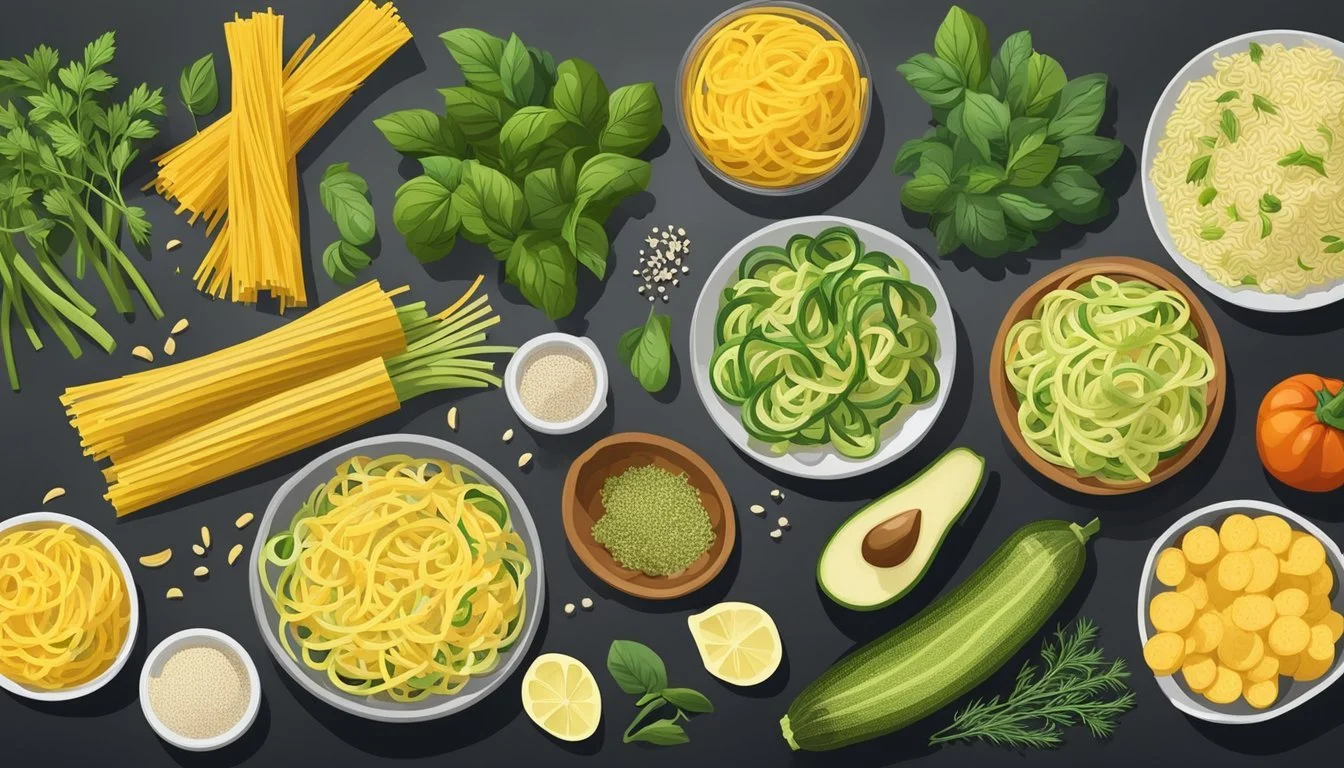Strozzapreti Pasta Substitutes
Top Alternatives for Your Recipes
Strozzapreti pasta (What wine goes well with pasta?), with its intriguing name meaning "priest strangler," has a place in Italian culinary tradition that combines history with a unique, twisted shape. This pasta, originating from the Emilia-Romagna and Tuscany regions of Italy, has a rustic and handmade appearance due to its rolled and elongated structure, which is renowned for its ability to cling to sauces. Its textured surface and density make it a hearty choice for a range of dishes, from classic marinara to more elaborate creamy or meaty sauces.
While Strozzapreti itself offers a distinct dining experience, it’s not always readily available in every grocery store or pantry. Fortunately, pasta lovers can opt for alternatives without sacrificing the essence of their dish. Substitutes like casarecce, gemelli, or fusilli can mimic the characteristics of Strozzapreti, thanks to their similarly intricate shapes that are adept at holding onto sauces and offering a satisfying bite.
Identifying the best substitute for Strozzapreti involves considering the pasta’s shape, texture, and the type of recipe one is looking to create. Pasta shapes like casarecce and gemelli are not only visually comparable but also bring a similar texture to the plate, making them excellent alternatives when Strozzapreti is not available. Whether one is trying to replicate a traditional Italian dish or simply seeking a pasta that adds a twist to standard fare, the right substitute can deliver an authentic and enjoyable pasta experience.
Understanding Strozzapreti Pasta
In Italian cuisine, strozzapreti stands out as a distinctive pasta with a rich cultural backstory and a unique form that sets it apart on the table.
History and Origin
Strozzapreti pasta, often translated as priest strangler in English, has its roots in the Emilia-Romagna region of Italy. The name carries a colorful legend, with tales suggesting that it was so delicious that it could metaphorically "choke" a gluttonous priest. This pasta is steeped in Italian culinary traditions, reflecting both the region's expertise in hand-shaped pasta and the local folklore.
Characteristics of Strozzapreti
Strozzapreti features an elongated, twisted shape that resembles a rolled towel. This irregular form allows sauces and seasonings to cling thoroughly, enhancing the flavor with each bite. Unlike other pastas, strozzapreti does not have a uniform size, but it typically reaches about 2-3 inches in length.
Appearance: Rolled and twisted, resembling a towel.
Texture: Firm, with a satisfying chew when properly cooked.
Size: Generally, 2-3 inches in length.
Region: Emilia-Romagna, renowned for handcrafted Italian pasta.
When one prepares strozzapreti, the pasta shape's distinct character comes to light, holding onto sauces and delivering the robust flavors of Italian cuisine.
Strozzapreti Pasta Substitutes
When a recipe calls for strozzapreti pasta, there are several suitable substitutes that maintain the integrity of the dish. The following suggestions cater to various dietary needs and pantry availability.
Alternative Pasta Types
For those seeking similar pasta shapes to strozzapreti, casarecce and gemelli are top choices due to their twisted appearance. They are versatile and can hold onto sauces well just like strozzapreti. Another shape to consider is cavatelli, which offers a similar bite.
Casarecce
Gemelli
Cavatelli
Gluten-Free Options
Gluten-free diets can incorporate alternative pasta made from rice, corn, or quinoa. These pastas have come a long way in texture and taste, closely mimicking traditional pasta.
Rice pasta
Corn pasta
Quinoa pasta
Vegetable-Based Substitutes
Vegetable noodles are a nutritious substitute, with spaghetti squash, butternut squash, and sweet potatoes providing a hearty base that still captures the essence of pasta dishes (What wine goes well with pasta dishes?).
Spaghetti squash
Butternut squash
Sweet potato noodles
Protein-Rich Alternatives
For those looking to add more protein to their meal, consider pastas made from legumes such as lentils or chickpeas, which provide a significant protein boost and a firm texture.
Lentil pasta
Chickpea pasta
Pantry Staples as Substitutes
When the pantry is your main source, rigatoni or lasagna noodles cut into smaller pieces can stand in for strozzapreti. They tend to be easier to find and can often be a practical option.
Rigatoni, cut if needed
Lasagna noodles, cut into strips
Alternative Ingredients and Flavors
In seeking to replicate or enhance the flavors of Strozzapreti pasta, one should consider a range of alternative ingredients. The focus is on complementing the pasta's unique texture and form with sauces, seasonings, and add-ins that honor its Italian roots.
Sauces and Seasonings
The choice of sauce is pivotal in pasta dishes. Pesto and tomato sauce are classic pairings that can be homemade or purchased. Pesto, typically made with fresh basil, garlic, pine nuts, Parmesan, and olive oil, lends a flavorful punch. A well-made tomato sauce, simmered with garlic and olive oil, can bring acidity and richness that resonates well with the pasta's shape and texture.
For Pesto:
Fresh basil: Essential for an authentic taste.
Garlic: Adds a piquant note.
Olive oil: Provides a smooth and rich base.
For Tomato Sauce:
Garlic: Again, brings zest and depth.
Olive oil: Used to sauté and add silkiness.
Cherry tomatoes: Offer a fresh and tangy twist.
Herbs and Spices
Simple yet powerful, herbs, and spices effortlessly infuse Strozzapreti with Italian flavors. Sage, with its earthy and slightly peppery taste, pairs well with unsalted butter for a modest sauce that allows the pasta to shine. Basil provides a sweet and peppery aroma, bringing freshness to every bite. The intensity of these flavors should be balanced to not overpower the delicate nature of Strozzapreti.
Common Herbs and Spices:
Sage: Muted yet distinctive; ideal with butter.
Garlic: A staple for its assertive taste.
Lemon zest: Infuses a citrusy brightness.
Garnishes and Add-Ins
The finale to a perfect Strozzapreti dish comes with thoughtful garnishes and add-ins which can enhance both the aesthetic and the flavor profile. A sprinkle of Parmesan or Pecorino cheese can add a savory touch, while a zest of lemon can provide just the right accent of freshness.
Preferred Garnishes and Add-Ins:
Parmesan: Offers a nutty and salty finish.
Pecorino Cheese: Slightly sharper than Parmesan; a bolder flavor.
Unsalted Butter: Can enrich and bring cohesiveness to the dish.
Cooking Techniques for Substitutes
When substituting strozzapreti pasta, the key is to match its dense, chewy texture and to handle the dough correctly, whether using alternative pastas or making them from scratch. Below are focused techniques to ensure your pasta substitute maintains the traditional qualities.
Achieving the Perfect Texture
For substitutes like spiralized vegetables or alternative pasta shapes, the goal is to reach an al dente texture. Vegetables should be cooked until barely tender, which typically takes 1 to 2 minutes. For grain-based pasta, cook them in boiling water and test frequently until they provide slight resistance to the bite. If using a skillet to finish cooking pasta, adding a small amount of the pasta cooking water can help the sauce cling to the pasta while maintaining the desired texture.
Using a Pasta Machine
If one is working with pasta dough, using a pasta machine can yield uniform and consistent results. For the best consistency, it is often recommended to mix all-purpose flour with semolina to give the dough the necessary elasticity and bite. Roll out the dough until it is thin enough to not be doughy, yet thick enough to hold its shape, usually setting the pasta machine to a mid-range thickness setting.
Hand-Shaping Pasta Alternatives
For hand-shaped substitutes such as homemade strozzapreti, it is crucial to start with the right dough consistency. It should be smooth and elastic after about 4 to 5 minutes of kneading by hand on a floured surface. Those who do not have a pasta machine may cut the dough into strips and then roll them by hand to create the twisted, rolled shape characteristic of strozzapreti. Allow the shaped pasta to rest briefly on a floured surface before cooking to ensure it maintains its form during the boiling process.
Nutritional Considerations
When considering substitutions for strozzapreti pasta, one should examine the nutritional composition of alternatives, focusing on calorie and carbohydrate content, dietary fiber and whole grains, as well as the potential for increasing vegetable intake.
Calorie and Carbohydrate Content
Traditional strozzapreti pasta, primarily composed of wheat, carries a significant amount of calories and carbohydrates. Substitutes like quinoa pasta offer a lower-calorie option with a similar macronutrient profile, making it a suitable alternative for those monitoring their caloric and carbohydrate intake.
Dietary Fiber and Whole Grains
Substitutes such as whole grain varieties offer higher fiber content compared to traditional pasta. This is essential for digestive health and can provide longer-lasting satiety. Spinach and zucchini noodles significantly increase the antioxidant and vitamin content of a meal while also providing dietary fiber, albeit in different amounts than grain-based pastas.
Incorporating More Vegetables
Vegetable-based substitutions like zucchini spirals not only reduce calorie and carbohydrate content but enrich the diet with vitamins and antioxidants. Conversely, spinach pasta can amplify iron and vitamin K intake. These alternatives facilitate an increased intake of vegetables, contributing to a well-rounded, nutrient-dense diet.
Creating Balanced Meals
Creating meals with Strozzapreti pasta can be a nutritious endeavor by incorporating a diverse range of vegetables and proteins, and by planning meals strategically to utilize leftovers efficiently.
Combining with Vegetables and Proteins
When preparing Strozzapreti pasta, one can enhance the meal's nutritional profile by adding a variety of vegetables and proteins. A healthful dish might include pairing Strozzapreti with broccolini and Italian sausage, or for seafood lovers, combining it with squid or clams. For vegetarian options, mixing in sautéed mushrooms or peas provides substantial protein and complements the pasta's chewy texture.
To illustrate, here's an example of a balanced Strozzapreti dish:
Italian Sausage & Vegetables: Combine a savory mix of sliced Italian sausage, lightly sautéed broccolini, and tender peas with the pasta for a fulfilling and flavorful meal.
Seafood Delight: Toss strozzapreti with pan-cooked clams and squid in a garlic-infused olive oil sauce, garnished with fresh parsley for an Italian-inspired seafood pasta.
Planning for Leftovers
One should not overlook the opportunity that leftovers offer. They can easily be transformed into new meals with minimal effort. For instance:
Cooked Strozzapreti pasta with vegetables like asparagus or broccolini can be reheated the next day with an added sprinkle of cheese or a dash of olive oil to restore moisture.
Proteins such as clams or Italian sausage from a previous meal can be sliced and mixed into an omelet or added to a quick pasta frittata.
It's beneficial to prepare extra quantities to ensure there is enough for subsequent meals. Leftovers should be stored in airtight containers to maintain freshness. Here is a simple table for storing leftovers:
Ingredient Refrigerated (up to) Notes Strozzapreti 3-5 days Best reheated with added moisture Cooked Vegetables 3-5 days Can be eaten cold or reheated Seafood 1-2 days Consume quickly for best quality Cooked Sausage 3-4 days Slice before reheating
By incorporating a blend of vegetables and proteins with Strozzapreti pasta and by reimagining leftovers, one can prepare nutritious and appetizing meals that are both convenient and enjoyable.
Regional Italian Pasta Specialties
Italy's rich tapestry of pasta varieties is as diverse as its regional cultures, each area boasting its own specialty dishes that reflect local flavors and historical influences.
Exploring Pasta Varieties from Italy
Italy offers an incredible range of pasta, each region presenting its own unique shapes and textures. For instance, Abruzzo is known for its chitarra pasta, a spaghetti-like noodle traditionally cut on a tool resembling a guitar. On the heels of tradition, pasta from this region often pairs with hearty lamb sauces or with delicate seafood along the Adriatic coast.
Further South, in the sun-kissed regions like Campania, pasta takes on shapes like vesuvio, inspired by the volcano that looms over Naples, resembling little twisted cones designed to capture sauce within their crevices. In Liguria, one finds corzetti, a distinctive coin-shaped pasta often stamped with intricate designs, which are perfect for holding onto the region's famous pesto.
Signature Dishes from Abruzzo and Beyond
Moving across the Italian landscape, Abruzzo showcases busiate, a corkscrew-shaped pasta that is traditionally served with a Trapanese pesto made from tomatoes and almonds, a testament to the cross-cultural influences that have shaped Italian cuisine.
The northwestern region often features pasta tossed with rich sauces, and it’s not uncommon to find a dish accented with prosciutto—a dry-cured ham that is a staple in many Italian kitchens. Paired with creamy sauces or a simple drizzle of olive oil, the saltiness of prosciutto complements the mild flavors of fresh pasta.
Each pasta shape perfectly captures the essence of its region, from the rolling hills of Abruzzo to the bustling streets of Napoli. These regional specialties are an invitation to explore Italy one dish at a time.







